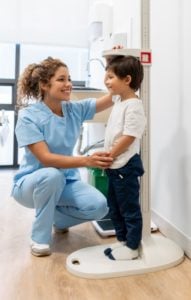 Medical assistants encounter patients of all ages, from one week to 100 year olds. In some ways, pediatric and geriatric patients are very different. But in other ways, they’re very similar. It helps to understand what your experience might be like across the age spectrum, so that you can seek out jobs catered to your own interests and goals. While some healthcare facilities might specialize in one age group or the other, some, like urgent care clinics, see both. In this blog post, Prism Career Institute compares and contrasts what it’s like working with pediatric and geriatric patients.
Medical assistants encounter patients of all ages, from one week to 100 year olds. In some ways, pediatric and geriatric patients are very different. But in other ways, they’re very similar. It helps to understand what your experience might be like across the age spectrum, so that you can seek out jobs catered to your own interests and goals. While some healthcare facilities might specialize in one age group or the other, some, like urgent care clinics, see both. In this blog post, Prism Career Institute compares and contrasts what it’s like working with pediatric and geriatric patients.
The Pediatric Experience
Pediatric medical assistants work with infants, children and teens up to 18 years of age. While you perform the same duties as you would with any patient, such as taking vitals and collecting medical history, the nature of the visit looks a little bit different. In-between recording height and weight, you might be making age-appropriate jokes and asking about the child’s hobbies and pets to make them feel relaxed. Kids frequently feel scared or upset about going to the doctor and sometimes they might also get bored, so a medical assistant may have to use tactics to distract or entertain the patient. A lot of times, the visits will be centered on well-child checkups, vaccinations, injuries and colds, flus and allergies.
The Geriatric Experience
On the other end of the spectrum, you have the geriatric, or elderly, patients. Again, your duties as a medical assistant remain much the same. However, there are a few unique aspects to the job. For one, taking patient history can be challenging because older patients have decades of information to record and sometimes take very long lists of medications. You have to be mindful of how these different medications interact with each other. Geriatric medical assistants may also have to help patients more if they have mobility, auditory or visual difficulties. While talking to them, you should also be vigilant for common health concerns, looking out for indicators such as forgetfulness and social isolation. In addition, taking an elderly person’s vitals can be challenging, especially when it comes to drawing blood, due to the effects of aging.
Similarities Between Pediatric and Geriatric Patients
Even though pediatric and geriatric patients are on the complete opposite ends of the age spectrum, they’re actually quite similar. For both, medical assistants have to exercise a lot of patience and compassion. Babies and children might be uncooperative, and elderly patients might move slower or need more help. In addition, it’s common for both ages to bring someone to the appointment with them. Kids will be accompanied by a parent and elders sometimes bring a spouse, caretaker or relative with them. So you’ll frequently be dealing with more people in the room than just the patient. While it’s important to focus on what the patient has to say, the second person might be able to offer helpful insights.
Another similarity is that education is key for both age groups. Medical assistants have to be good at explaining things in a way that patients can understand, whether that’s helping them figure out medication schedules or talking about developmental milestones. A lot of conversations will also revolve around injury prevention, physical activity and nutrition – only the information you provide will be different for each.
An Education for All Ages
No matter what age group you hope to work with in the future, Prism Career Institute prepares you for every situation. Our Medical Assistant Program in Cherry Hill and West Atlantic City teaches students everything they need to know for a successful and fulfilling career in the field. Learn more about what the program has to offer today.
